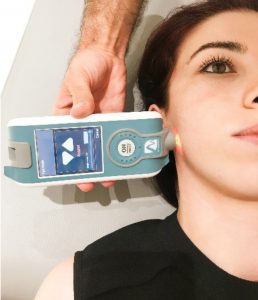Publications

Evaluation of the tone and viscoelastic properties of the masseter muscle in the supine position, and its relation to age and gender
Authors: Engin Ramazanoglu 1, Begumhan Turhan 2, Serkan Usgu 2
Affiliations:
- Department of Physiotherapy and Rehabilitation, Faculty of Health Sciences, Inonu University, Malatya, Turkey
- Department of Physiotherapy and Rehabilitation, Faculty of Health Sciences, Hasan Kalyoncu University, Gaziantep, Turkey
Journal: Dental and Medical Problems - June 2021, Volume 58, Issue 2, Pages 155-161 (DOI: 10.17219/dmp/132241)
-
Field & Applications:
- Medical
- Orofacial muscles
- Gerontology / Ageing
- Musculoskeletal health
- Normatives
- Validity
Background: The masseter muscle can be evaluated in various ways to examine its condition in healthy individuals or to identify pathological changes in the muscle.
Objectives: This study aimed to examine the tone and viscoelastic parameters of the masseter muscle, which is the focal muscle of various pathologies, to reveal its relationship with age and gender, and to determine the reference values of this muscle in healthy individuals.
Material and methods: Individuals aged 18-50 years were evaluated. They were divided into 3 groups in terms of age. A total of 389 individuals participated in the study (18-28 years: 131 males, 104 females; 29-39 years: 29 males, 56 females; and 40-50 years: 30 males, 39 females). The tone and viscoelastic properties of the masseter muscle were evaluated bilaterally in the supine position.
Results: The mean age of all individuals was 28.64 ± 9.68 years. The masseter muscle tone was found to be higher in men than in women. The elasticity of the muscle was higher in women (p < 0.05). It was determined that the masseter muscle tone and stiffness increased, whilst its elasticity decreased with aging (p < 0.05). A weak positive correlation was found between the right and left masseter muscle tone and age (r = 0.307 and r = 0.325, respectively; p = 0.001). There was a moderate positive correlation between the right and left masseter muscle stiffness and age (r = 0.507 and r = 0.511, respectively; p = 0.001). A strong positive correlation was observed between the right and left masseter muscle elasticity and age (r = 0.614 and r = 0.645, respectively; p = 0.001).
Conclusions: The data obtained in this study may assist clinicians in evaluating the treatment of the pathological conditions related to the masseter muscle as well as in the planning of treatment and pre- and post-operation evaluations.

Fig. 1. Evaluation of the mechanical properties of the masseter muscle
Keywords: aging, gender identity, masseter muscle, muscle tone, viscosity
The tone and viscoelastic parameters of the masseter muscle can be examined using different evaluation methods to compare pre and posttreatment changes in the muscle in fields such as plastic surgery, dentistry, physical therapy and rehabilitation, and speech and language therapy. We hope that the results of our study can provide the reference values for studies in these fields.


